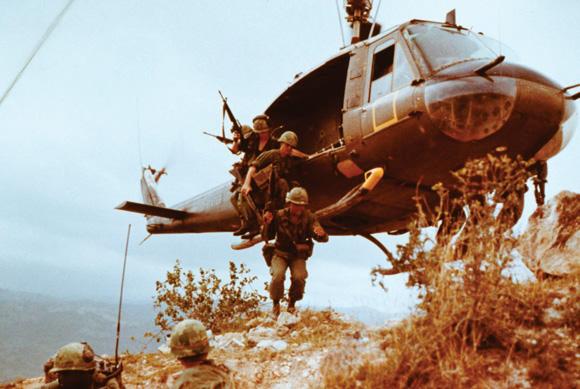試す 金 - 無料
LAST FLIGHT OF THE AIR CAVALRY?
History of War
|Issue 148
Originally supplanting paratroops as a means of delivering soldiers precisely onto the battlefield, air assault became the standard for strategic planning in the Cold War. But as air threats have escalated, has peer-on-peer conflict made the tactic obsolete?

Military helicopter operations came of age during the war in Vietnam in the late 1960s. The NBC evening news broadcasts beamed into US homes in the evenings showed fleets of UH-1 Hueys, with the familiar 'slap' of their blades echoing across the jungles as they hovered over clearings. At the same time, soldiers jumped from the helicopter skids and ran into battle. It was the age of 'search and destroy' tactics, with troops no longer having to march to where the fighting was taking place - they could now be taken directly to it, engage, before being picked up and taken back to the safety of their base.
The concept of the helicopter air assault was continuously developed and adapted during the war. It saw the creation of the Ist Cavalry Division (Airmobile), better known as the 'Ist Air Cav', an army division trained from the outset to operate in unison with helicopters, which they'd ride into battle. Although this new concept presented a tactical advantage, it came at the cost of more than 5,000 of the approximately 12,000 helicopters used during the conflict, as well as countless lives, as landing zones became the fiercest battles of the entire war.
By the latter decades of the Cold War, large-scale helicopter air assaults were still being openly discussed by senior military planners as a way to wage war on the battlefield under the heading of an 'AirLand Battle' or as part of an 'Active Defence' strategy. The Soviet Union suffered horrific air losses during the Afghanistan War, with its Mi-8 Hips and Mi-24 Hinds routinely shot down by ground fire, only for them to shift to a tactic of flying at higher altitudes. Here, they came within the range of CIA-supplied Stinger, shoulder-launched surface-to-air missiles, and were downed in their hundreds, with little chance of survival for the crew and troops aboard.
このストーリーは、History of War の Issue 148 版からのものです。
Magzter GOLD を購読すると、厳選された何千ものプレミアム記事や、10,000 以上の雑誌や新聞にアクセスできます。
すでに購読者ですか? サインイン
History of War からのその他のストーリー

History of War
FLYING INTO HISTORY ENOLA GAY
The first atomic bomb was dropped on Japan by an American B-29 bomber, preceding the country's capitulation in WWII. Here navigator Theodore Van Kirk recalls his experience of the day that changed history
7 mins
Issue 149

History of War
PUTIN'S SUBMARINE FLEET
From the Cold War to modern operations, the threat beneath the waves has been steadily building, and could be about to escalate
4 mins
Issue 149

History of War
ON SILVER WINGS
THIS MOVING BIOGRAPHY OF AN 'UNKNOWN' WWII RAF FIGHTER ACE CHARTS DESMOND IBBOTSON'S CAREER, THE STORY ENDING WITH A TWIST WHEN HIS REMAINS ARE DISCOVERED IN ITALY IN 2005
2 mins
Issue 149

History of War
CAMBODIA vs THAILAND ROOTS OF THE BORDER WAR
July 2025's clashes are the latest in a long frontier conflict that has gone unresolved, from the era of warrior kings to smart bombs
4 mins
Issue 149

History of War
TASK FORCE GREMLIN
At the end of WWII the Japanese Imperial Army Air Force was conscripted into the Royal Air Force in Southeast Asia
7 mins
Issue 149

History of War
RAF RETURNS TO NUCLEAR
Nearly 30 years after giving them up, the RAF is poised to reacquire air-dropped nuclear weapons
3 mins
Issue 149

History of War
NO MORE NAPOLEONS
A MAGISTERIAL SURVEY OF NAVAL POWER AND POLICY
2 mins
Issue 149

History of War
STALIN'S BLITZKRIEG
In the final month of WWII, the Red Army launched a devastating strike into Manchuria, opening a new front with Japan and threatening invasion of the Home Islands
10 mins
Issue 149

History of War
BALACLAVA POCKET WATCH
This William IV silver timepiece and its owner survived the Charge of the Light Brigade at the Battle of Balaclava
1 mins
Issue 149

History of War
THE END OF THE SPY?
Human intelligence is a dying art, but it is still crucial for security agencies worldwide
3 mins
Issue 149
Listen
Translate
Change font size
